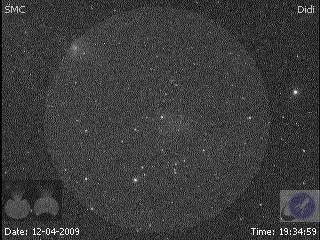The IYA Live Telescope broadcasting on “Galactic TV” has been busy fillling your requests and we hope UT reader Didi had a chance to follow the Small Magellanic Cloud for several hours in the remote telescope on April 12! (I was still down and out, but it was still there despite the moonlight!) Come on inside… Your request has been fulfilled and your images are waiting!
The following is a cut and paste from Wikipedia:
Object: Small Magellanic Cloud – Constellation: TUCANA
The Small Magellanic Cloud (SMC) is a dwarf galaxy. It contains several hundred million stars. Some speculate that the SMC was once a barred spiral galaxy that was disrupted by the Milky Way to become somewhat irregular. It still contains a central bar structure. At a distance of about 200,000 light-years, it is one of the Milky Way’s nearest neighbors. It is also one of the most distant objects that can be seen with the naked eye.
With a mean declination of approximately -73 degrees, it can only be viewed from the Southern Hemisphere and the lower latitudes of the Northern Hemisphere. It is located in the constellation of Tucana and appears as a hazy, light patch in the night sky about 3 degrees across. It looks like a detached piece of the Milky Way. Since it has a very low surface brightness, it is best viewed from a dark site away from city lights. It forms a pair with the Large Magellanic Cloud (LMC), which lies a further 20 degrees to the east. The Small Magellanic Cloud is a member of the Local Group.
In the southern hemisphere, the Magellanic clouds have long been included in the lore of native inhabitants, including south sea islanders and indigenous Australians. Persian astronomer Al Sufi labelled the larger of the two clouds as Al Bakr, the White Ox. European sailors may have first noticed the clouds during the Middle Ages when they were used for navigation. Portuguese and Dutch sailors called them the Cape Clouds, a name that was retained for several centuries. During the circumnavigation of the Earth by Ferdinand Magellan in 1519–22, they were described by Antonio Pigafetta as dim clusters of stars.[6] In Johann Bayer’s celestial atlas Uranometria, published in 1603, he named the smaller cloud, Nubecula Minor. In Latin, Nubecula means a little cloud.
Between 1834 and 1838, John Frederick William Herschel made observations of the southern skies with his 20-foot (6.1 m) reflector from the Royal Observatory at the Cape of Good Hope. While observing the Nubecula Minor, he described it as a cloudy mass of light with an oval shape and a bright center. Within the area of this cloud he catalogued a concentration of 37 nebulae and clusters.
In 1891, Harvard College Observatory opened an observing station at Arequipa, Peru. From 1893 and 1906, under the direction of Solon Bailey, the 24-inch (610 mm) telescope at this site was used to survey photographically both the Large and Small Magellanic Clouds. Henrietta Swan Leavitt, an astronomer at the Harvard College Observatory, used the plates from Arequipa to study the variations in relative luminosity of stars in the SMC. In 1908, the results of her study were published, which showed that a type of variable star called a “cluster variable”, later called a Cepheid variable after the prototype star Delta Cephei, showed a definite relationship between the variability period and the star’s luminosity. This important period-luminosity relation allowed the distance to any other cepheid variable to be estimated in terms of the distance to the SMC. Hence, once the distance to the SMC was known with greater accuracy, Cepheid variables could be used as a standard candle for measuring the distances to other galaxies.
Using this period-luminosity relation, in 1913 the distance to the SMC was first estimated by Ejnar Hertzsprung. First he measured thirteen nearby cepheid variables to find the absolute magnitude of a variable with a period of one day. By comparing this to the periodicity of the variables as measured by Leavitt, he was able to estimate a distance of 10,000 parsecs (30,000 light years) between the Sun and the SMC. This later proved to be a gross underestimate of the true distance, but it did demonstrate the potential usefulness of this technique.

We would like to once again thank Didi for the request and remind you that you can always watch our IYA telescope “live” whenever skies are clear and dark in Central Victoria by simply clicking on the logo “Live Remote Cam” to your right. Enjoy!
(Information Source: Wikipedia.)


Hi Tammy,
thank you and to all the others involved in this great stuff!
Clear skies and open minds.
Didi